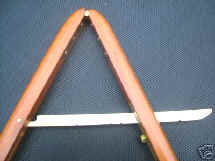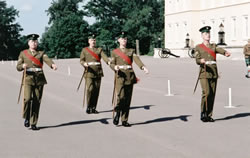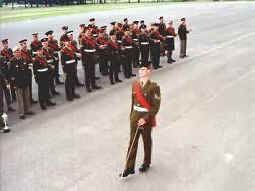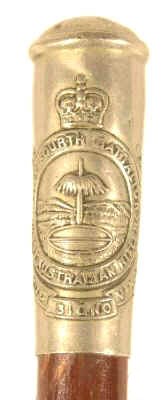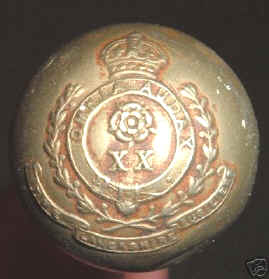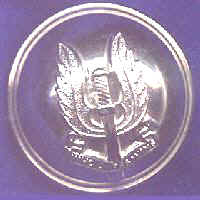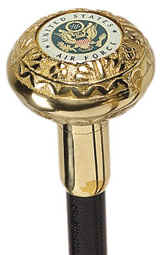 |
|
|||
|
|
||||
| The RSM's Pace Stick (see below for Swagger Sticks) | |
|
The RSM of a Unit carries a 'Pace Stick" which originated in the Artillery as a "Gunner's Stick" and was used to measure the distance between guns. It was soon adapted to measure the length of the pace taken by soldiers to get them all pacing the same. The Pace Stick is actually two pieces of timber, hinged at the top and able to be set to a particular distance, something like the compass set you used at school. Regimental Sergeant Major of The
Army Note the Pace Stick, Infantry Combat Badge, Sam Browne Belt. Note the Badge of Rank that is worn ONLY by the RSM Army. >>> |
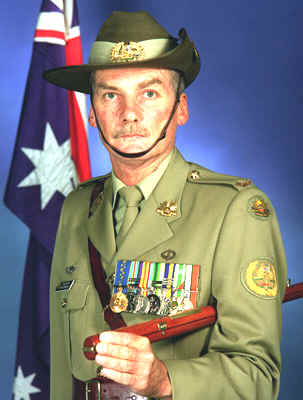 |
| The Pace Stick - The Royal Regiment of Artillery was the originator of the pace stick. It was used by gunners to ensure correct distances between guns on the battlefield, thus ensuring the appropriate effective fire. The original stick was more like a walking stick, with a silver or ivory knob. It could not be manipulated like the modern pace stick as it only opened like a pair of callipers; the infantry then developed the stick to its present configuration as an aid to drill. (from the Dept of Defence site) |
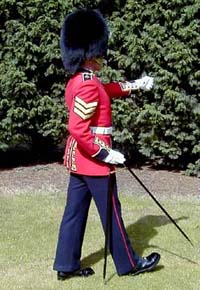
|
<< British Drill Instructor demonstrates the practical use of a Pace stick |
| A young Officer Cadet at Sandhurst Military College several years ago, was taken aside by a Guards Sergeant Major to be told that his performance on the drill square had been "distinctly sub-optimal". The Sergeant Major thrust his pace stick roughly into the ribs of the poor unfortunate and bellowed at him, "There is a complete idiot at the end of this pace stick." The cadet replied, "Not at this end, Sergeant Major." |
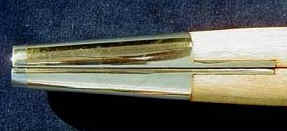 |
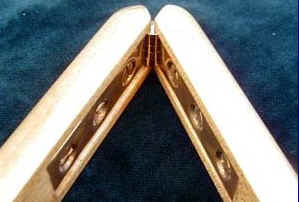 |
| The ferrules on the end of a pace stick | The hinged top of a pace stick |
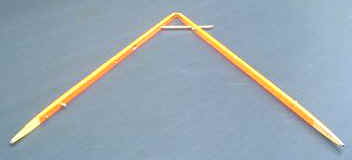 |
|
|
The spring lock fitting allows the pace stick to be set at different pace lengths. |
|
Pace
Stick Drill. In 1952 the Royal Military Academy Sergeant
Major, John Lord, started the pace stick competition as a test in the
use of the pace stick. The team consists of 4 members 3 pacers and a
driver who paces at the back of the team.
The Royal Regiment of Artillery in Britain claims to be the originator of the pace stick. Their field gun teams used the pace stick to ensure correct distances between the guns. At that time the artillery used the pace stick in an open position, like a pair of calipers, and not like the drill stick which is adjustable to various settings. From the beginning the infantry used the pace stick as a drill aid. In 1982 Arthur Brand M.V.O. M.B.E. developed the drills for the pace stick. The stick he used is still carried by the Academy Sergeant Major at the Royal Military Academy, Sandhurst. The objective of the pace stick drill is to provide uniformity in the use of the stick and a high standard of steadiness and cohesion amongst the instructors. The stick is used to determine the correct length of the pace, distance between the ranks and to check drill movement. The instructor marches with the stick open next to the squad. By using the stick he can check the length of the pace, and then lengthen or shorten the pace. from http://www.bydand.co.za/cth/Pacestick.htm |
||||||
|
Swagger Sticks as used by the CSM & Officers |
||||
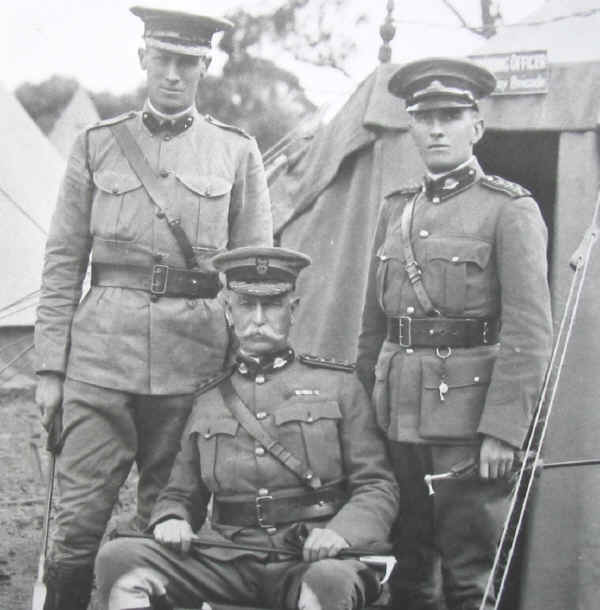 |
||||
| 3 Officers, including Colonel Ricardo, "The Father of QMI" when he was Military Commandant of Victoria circa 1905. Note that they all carry a swagger stick. | ||||
|
|
||||
|
|
It is a cane, timber or
leather covered stick carried by Company Sergeants Major and some
Commissioned Officers. They probably had their genesis in a riding
crop with the mounted units in the British Army. The model above is more
ornate than most. Not many have the "T" piece. In the
British Army it is common to have the Regimental Badge on the top of
the stick. I have not seen that done in Australia but it may be.
The Ash Plant. During World War I walking sticks were often carried by officers. Such sticks came to have a new and greater use with the introduction of tanks which often became 'bogged' on battlefields, particularly in Flanders. Officers of the Tank Corps used these sticks to probe the ground in front of their tanks testing for firmness as they went forward. Often the commanders led their tanks into action on foot. To commemorate this, officers of the Regiment carry Ash Plant Sticks instead of the short cane customary to other Arms. |
|||
|
|
| Cane
swagger stick with a white metal foot and ball top. The ball is made in
two pieces, the join being around the equator, and features a raised 41
Battalion (The Byron Regiment) badge on the upper half. Charles Hercules
Green was born in December 1919 at Grafton, NSW. Despite serious
injuries suffered when he was kicked in the face by a horse at age 11,
he began working on his father's dairy farm in 1933, and soon joined the
local 41 (Militia) Battalion. By the outbreak of war in 1939, he held
the rank of lieutenant in the Militia, and in October he transferred to
the AIF, holding the same rank. Posted to the 2/2 Battalion, which
reached the Middle East in early 1940, his foot was burned by an
upturned stove, and complications from this injury prevented him from
participating in the battalion's early engagements in North Africa.
Rejoining his unit in Greece in March 1941, Green, now a Captain,
survived the Allied retreat, and led a group of men in a hazardous
escape to Palestine via Turkey.
Returning to Australia in 1942, 2/2 Battalion was soon sent to New Guinea, while Green, suffering from illness and an injured foot, was hospitalised for some months. As major and second-in-command, he rejoined the unit in 1943, proceeding to New Guinea the following year. In March 1945, promoted acting lieutenant colonel, he took command of 2/11 Battalion, becoming, at the age of 25, the youngest Australian battalion commander of the war. For his leadership of the unit in the fighting around Wewak, Green was awarded the DSO. Post war, having trouble adjusting to peacetime life, he returned to Militia service as commander of his old 41 Battalion, and eventually joined the regular army in 1949. In mid 1950 he was taken from Staff College to lead 3 RAR, which was then preparing for active service in Korea. He took command in September 1950, and led the unit in a series of highly successful actions against North Korean forces, but died of wounds caused by an enemy shell while he was asleep in his tent near the Tokchon River on 31 October. A decisive and energetic leader, Charlie Green was revered by his men, and considered to be one of Australia's finest battlefield commanders. |
 |
|
 |
|
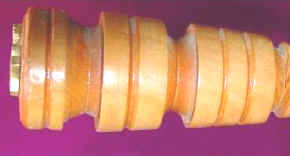 |
 |
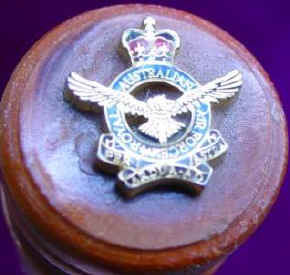 |
|
| RAAF swagger stick of turned timber with the RAAF crest on the top. | 20th Battalion Lancashire Fusiliers, head of a swagger stick |

|
Decorative head of a USAF Swagger stick, 2004. |
 |
| Current model swagger stick, available in brown or black, with matching stand. The stick is tipped with a .50 bullet & shell. Available from Christies. |
|
Sword Canes |
|
 |
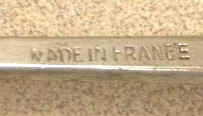 |
|
"Made in France" stamped on blade |
|
| Some Officers and Warrant Officers, and some civilians, who were posted to dangerous cities or countries took to carrying a swagger stick with a concealed rapier style triangular blade that could be used to ward off "ruffians" or "evil-doers". | |
|
|
|
The Swagger Stick by Blackie Cahill, Colonel of Marines, USMC
In
the Marine Corps, the swagger stick came into vogue in the latter part
of the 19th century, and was a required article of uniform until WWI. The
first actual presentation of the swagger stick was made in 1569 when
Charles IX of France made his brother Henry a Generalissimo and gave him
one to signify his appointment.
In
1959, the Marine Corps had a new commandant. General D. M. Shoup had
changes on his mind when he took over the position. Most famous of these
changes was the banishing of the swagger stick to a place on the closet
shelf next to the "Sam Browne" belt . Shoup stated that a
clean, neat, well fitted uniform with the Marine Corps emblem was tops.
"There is one piece of equipment about which I have a definite
opinion. It is the swagger stick. |
